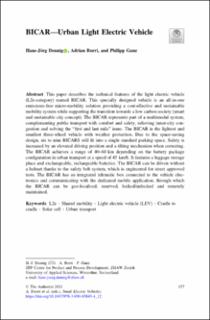Please use this identifier to cite or link to this item:
https://doi.org/10.21256/zhaw-22327| Publication type: | Book part |
| Type of review: | Peer review (publication) |
| Title: | BICAR : urban light electric vehicle |
| Authors: | Dennig, Hans-Jörg Burri, Adrian Ganz, Philipp |
| et. al: | No |
| DOI: | 10.1007/978-3-030-65843-4_12 10.21256/zhaw-22327 |
| Published in: | Small Electric Vehicles |
| Page(s): | 157 |
| Pages to: | 166 |
| Issue Date: | 22-Apr-2021 |
| Publisher / Ed. Institution: | Springer |
| Publisher / Ed. Institution: | Cham |
| ISBN: | 978-3-030-65842-7 978-3-030-65843-4 |
| Language: | English |
| Subjects: | Mobilität; Shared mobility; L2e; Light electric vehicle (LEV); Cradle to cradle; Solar cell; Urban transport |
| Subject (DDC): | 629: Aeronautical, automotive engineering |
| Abstract: | This paper describes the technical features of the light electric vehicle (L2e-category) named BICAR. This specially designed vehicle is an all-in-one emissions-free micro-mobility solution providing a cost-effective and sustainable mobility system while supporting the transition towards a low carbon society (smart and sustainable city concept). The BICAR represents part of a multimodal system, complementing public transport with comfort and safety, relieving inner-city congestion and solving the “first and last mile” issue. The BICAR is the lightest and smallest three-wheel vehicle with weather protection. Due to the space-saving design, six to nine BICARS will fit into a single standard parking space. Safety is increased by an elevated driving position and a tilting mechanism when cornering. The BICAR achieves a range of 40–60 km depending on the battery package configuration in urban transport at a speed of 45 km/h. It features a luggage storage place and exchangeable, rechargeable batteries. The BICAR can be driven without a helmet thanks to the safety belt system, which is engineered for street approved tests. The BICAR has an integrated telematic box connected to the vehicle electronics and communicating with the dedicated mobile application, through which the BICAR can be geo-localised, reserved, locked/unlocked and remotely maintained. |
| URI: | https://digitalcollection.zhaw.ch/handle/11475/22327 |
| Fulltext version: | Published version |
| License (according to publishing contract): | CC BY 4.0: Attribution 4.0 International |
| Departement: | School of Engineering |
| Organisational Unit: | Institute of Product Development and Production Technologies (IPP) |
| Appears in collections: | Publikationen School of Engineering |
Files in This Item:
| File | Description | Size | Format | |
|---|---|---|---|---|
| 2021_Dennig-Burri-Ganz_BICAR-Urban-Light-Electric-Vehicle.pdf | 677.67 kB | Adobe PDF |  View/Open |
Show full item record
Dennig, H.-J., Burri, A., & Ganz, P. (2021). BICAR : urban light electric vehicle. In Small Electric Vehicles (pp. 157–166). Springer. https://doi.org/10.1007/978-3-030-65843-4_12
Dennig, H.-J., Burri, A. and Ganz, P. (2021) ‘BICAR : urban light electric vehicle’, in Small Electric Vehicles. Cham: Springer, pp. 157–166. Available at: https://doi.org/10.1007/978-3-030-65843-4_12.
H.-J. Dennig, A. Burri, and P. Ganz, “BICAR : urban light electric vehicle,” in Small Electric Vehicles, Cham: Springer, 2021, pp. 157–166. doi: 10.1007/978-3-030-65843-4_12.
DENNIG, Hans-Jörg, Adrian BURRI und Philipp GANZ, 2021. BICAR : urban light electric vehicle. In: Small Electric Vehicles. Cham: Springer. S. 157–166. ISBN 978-3-030-65842-7
Dennig, Hans-Jörg, Adrian Burri, and Philipp Ganz. 2021. “BICAR : Urban Light Electric Vehicle.” In Small Electric Vehicles, 157–66. Cham: Springer. https://doi.org/10.1007/978-3-030-65843-4_12.
Dennig, Hans-Jörg, et al. “BICAR : Urban Light Electric Vehicle.” Small Electric Vehicles, Springer, 2021, pp. 157–66, https://doi.org/10.1007/978-3-030-65843-4_12.
Items in DSpace are protected by copyright, with all rights reserved, unless otherwise indicated.